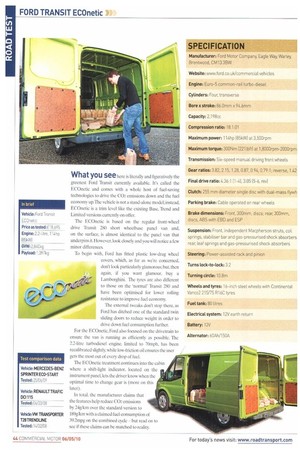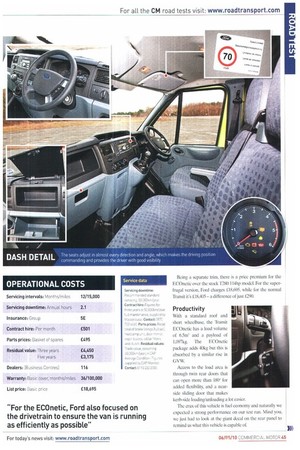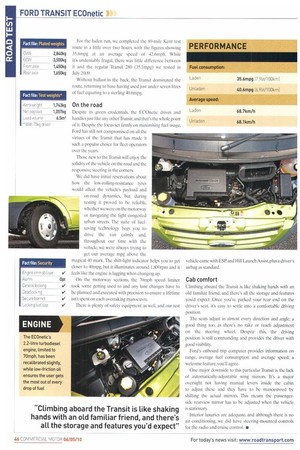What you see here is literally and figuratively the greenest
Page 44

Page 45

Page 46

If you've noticed an error in this article please click here to report it so we can fix it.
Ford Transit currently available. It's called the ECOnetic and comes with a whole host of fuel-saving technologies to drive the CO2 emissions down and the fuel economy up.The vehicle is not a stand-alone model; instead, ECOnetic is a trim level like the existing Base, Trend and Limited versions currently on offer.
The ECOnetic is based on the regular front-wheel drive Transit 280 short wheelbase panel van and, on the surface, is almost identical to the panel van that underpins it. However, look closely and you will notice a few minor differences To begin with, Ford has fitted plastic low-drag wheel covers, which, as far as we're concerned.
don't look particularly glamorous; but, then again, if you want glamour. buy a Lamborghini. The tyres are also different to those on the 'normal' Transit 280 and have been optimised for lower rolling resistance to improve fuel economy.
The external tweaks don't stop there, as Ford has ditched one of the standard twin sliding doors to reduce weight in order to drive down fuel consumption further.
For the ECOnetic, Ford also focused on the drive train to ensure the van is running as efficiently as possible. The 2.2-litre turbodiesel engine, limited to 70mph, has been recalibrated slightly, while low-friction oil ensures the user gets the most out of every drop of fuel.
The ECOnetic treatment continues into the cabin where a shift-light indicator, located on the instrument panel, lets the driver know when the optimal time to change gear is (more on this later).
In total, the manufacturer claims that the features help reduce CO2 emissions by 24g/km over the standard version to 189g/km with a claimed fuel-consumption of 39.2mpg on the combined cycle — but read on to see if these claims can be matched to realit:. Being a separate trim, there is a price premium for the ECOnetic over the stock T280 114hp model. For the superfrugal version. Ford charges f18,695, while for the normal Transit it's £18,405— a difference of just £290.
Productivity With a standard roof and short wheelbase, the Transit ECOnetic has a load volume of 6.5m5 and a payload of 1,097kg. The ECOnetic package adds 40kg but this is absorbed by a similar rise in GVW.
Access to the load area is through twin rear doors that can open more than 180' for added flexibility, and a nearside sliding door that makes kerb-side loading/unloading a lot easier.
The crux of this vehicle is fuel economy and naturally we expected a strong performance on our test run. Mind you, we just had to look at the giant decal on the rear panel to remind us what this vehicle is capable of. )))
For the laden run, we completed the 89-mile Kent test route in a little over two hours, with the figures showing 35.6mpg at an average speed of 42.6mph. While it's undeniably frugal, there was little difference between it and the regular Transit 280 (35.1mpg) we tested in July 2009.
Without ballast in the back, the Transit dominated the route, returning to base having used just under seven litres of fuel equating to a sterling 40.6mpg.
Ke 7D WC ight 1,743kg On the road
Net paytoad 1,057kg Despite its green credentials, the ECOnetic drives and
coad volume 6.5m3 handles just like any other Transit; and that's the whole point
' With 75kg driver of it. Despite the focus set firmly on maximising fuel usage.
Ford has still not compromised on all the virtues of the Transit that has made it such a popular choice for fleet operators over the years.
Those new to the Transit will enjoy the solidity of the vehicle on the road and the responsive steering in the corners.
We did have initial reservations about how the low-rolling-resistance tyres would affect the vehicle's payload and on-road dynamics, but during testing it proved to be reliable, whether we were on the motorway or navigating the tight congested urban streets. The suite of fuelsaving technology begs you to drive the van calmly and, throughout our time with the vehicle, we were always trying to get our average mpg above the magical 40 mark. The shift-light indicator helps you to get closer to 40mpg, but it illuminates around 1,800rpm and it feels like the engine is lagging when changing up.
On the motorway sections. the 70riph speed limiter took some getting used to and any lane changes have to be planned and executed with precision to ensure a lifetime isn't spent on each overtaking manoeuvre.
There is plenty of safety equipment as well, and our test vehicle came with ESP and Hill Launch Assist, plus a driver's airbag as standard.
Cab comfort
Climbing aboard the Transit is like shaking hands with an old familiar friend, and there's all the storage and features you'd expect. Once you've parked your rear end on the driver's seat, it's easy to settle into a comfortable driving position.
The seats adjust in almost every direction and angle; a good thing too, as there's no rake or reach adjustment on the steering wheel. Despite this, the driving position is still commanding and provides the driver with good visibility.
Ford's onboard trip computer provides information on range, average fuel consumption and average speed; a welcome feature, you'll agree.
One major downside to this particular Transit is the lack of automatically-adjustable wing mirrors. It's a major oversight not having manual levers inside the cabin to adjust these and they have to be manoeuvred by shifting the actual mirrors. This means the passengerside rearview mirror has to be adjusted when the vehicle is stationary.
Interior luxuries arc adequate, and although there is no air conditioning, we did have steering-mounted controls for the radio and cruise control. •




























































































































